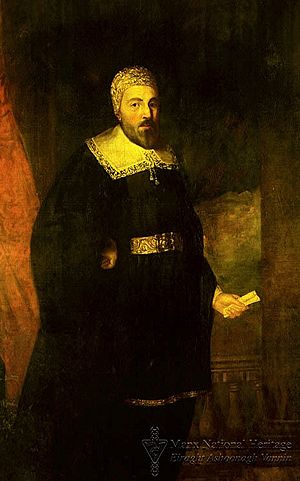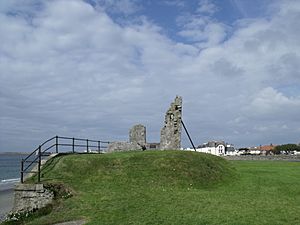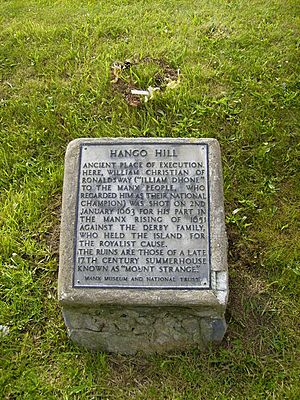Illiam Dhone facts for kids
Illiam Dhone or Illiam Dhôan (which means 'Brown William' in English) was born on April 14, 1608, and died on January 2, 1663. He was also known as William Christian.
Illiam Dhone was a Manx politician from the Isle of Man. Depending on who you ask, people see him as a hero, a rebel, or even a traitor. He was the son of Ewan Christian, who was a important judge called a deemster.
The name Illiam Dhone means Brown William in the Manx language. He got this name because he had dark hair. He played a big part in the Isle of Man during the English Civil War and the Manx Rebellion of 1651. He was put to death in 1663 for serious charges against the government. For hundreds of years after his death, many people have seen him as a "martyr" and a "folk-hero." He became a symbol of the Island's special freedoms and old traditions.
Contents
Illiam Dhone's Early Life
We don't know much about Illiam Dhone's early years. He was the third son of Ewan Christian and Katherine Harrison. He was probably born at his family's home in Derbyhaven, near Ronaldsway, in the south-east of the Island. This old farmhouse was taken down in the 1940s to make way for the Ronaldsway Airport.
Illiam's father, Ewan Christian, was a very important person in Manx politics. He served as a deputy-governor and a deemster (judge) for 51 years. He often disagreed with the Lord of Mann, James Stanley, 7th Earl of Derby. Their main disagreement was about an old way of owning land called the tenure of the straw. This system let families own their land forever and pass it down to their children without needing the Lord's permission. Lord Stanley wanted to change this to a lease that would only last for three generations. Ewan Christian fought against this change. In 1643, Ewan gave his property at Ronaldsway to his son, William (Illiam Dhone).
Edward Christian, who was a distant relative of Illiam Dhone and also the Governor of the Isle of Man, was put in prison in 1643. He was accused of planning against the Stanley family. He stayed in prison for eight years.
The Manx Rebellion of 1651
In 1648, Lord Stanley made Illiam Dhone the Receiver General. This was a big job, even though Stanley had problems with Illiam's father before. In 1651, Lord Stanley left the Isle of Man to fight for King Charles II in England. Illiam Dhone was put in charge of the island's local army, called the militia. Stanley's wife, Charlotte Stanley, Countess of Derby, stayed at Castle Rushen and was also under Illiam's protection. This shows how much Stanley trusted Illiam Dhone.
Lord Stanley was captured during the Battle of Worcester in September 1651. In a letter to his wife, he told her to try and get him freed by giving up the Isle of Man to the Parliamentarians. But she couldn't do it, and her husband was put to death on October 15.
Illiam Dhone and the Manx militia worried that the Countess might give up the Island in a way that would harm the Manx people. So, Illiam Dhone started talking with the Parliamentarians on his own. He agreed that the Manx people would not fight their ships if the Parliamentarians promised to bring back the "ancient rights and laws" that Lord Stanley had tried to change.
The Countess's attempt to trade the Isle of Man for her husband's freedom led to a revolt. This was called the Manx Rebellion of 1651. People were also unhappy about the land changes Lord Stanley wanted to make. Plus, the Manx people had to pay for soldiers staying on the island. About 800 men gathered at Illiam Dhone's property. The militia managed to take over the smaller forts. However, they could not take the two biggest castles, Peel Castle and Castletown Castle. When the Parliamentarian ships arrived in late October 1651, the Manx militia worked with them.
The Countess of Derby realized her own soldiers couldn't be trusted. She had to give up Castle Rushen and Peel Castle. Illiam Dhone remained the Receiver General. In 1656, he was even made Governor of the Isle of Man, which was the highest point in his career.
Illiam Dhone's Arrest and Trial
Being both Governor and Receiver General gave Illiam Dhone a lot of power over the Island's money. Two years later, in 1658, a new Governor named James Chaloner accused Illiam Dhone of misusing money. This money was supposed to help grammar schools and pay poorer church leaders. To avoid being arrested, Illiam Dhone and his oldest son, George, went to England. His properties were taken away, and his brother, Deemster John Christian, was put in prison for helping him escape.
Illiam Dhone was finally arrested in London in 1660. After being in prison for a year, he came back to the Isle of Man. He hoped that his past actions against the Earl of Derby would be forgiven under a new law called the Act of Indemnity of 1661. However, Charles Stanley, 8th Earl of Derby wanted to punish him. He ordered Illiam Dhone's arrest.
At his trial, Illiam Dhone refused to speak in his own defense. The House of Keys (the Manx parliament) then said that his life and property were up to the Lord of Mann. The Deemsters (judges) then gave their sentence. Illiam Dhone was put to death by shooting at Hango Hill (near Castletown) on January 2, 1663. The execution did not go as planned, and he died from his injuries.
Illiam Dhone's Legacy
This harsh act made King Charles II and his advisors angry. The judges and others involved were punished, and Illiam Dhone's family received some compensation.
Illiam Dhone is mostly remembered through a Manx song called Baase Illiam Dhône. This song has been translated into English. He is also mentioned in Sir Walter Scott's book, Peveril of the Peak.
Every year, groups like Mec Vannin and the Manx branch of the Celtic League hold a special event at the place where he was put to death.
Illiam Dhone is a person who causes different opinions in Manx history. Some people see him as someone who betrayed his leaders. Others see him as a patriotic hero who fought for the rights of the Manx people.
The main building for the Office of Human Resources of the Isle of Man Government is named Illiam Dhone House.
In January 2006, a monument created by Bryan Kneale was put up at Malew Church, where Illiam Dhone is buried.
Images for kids







